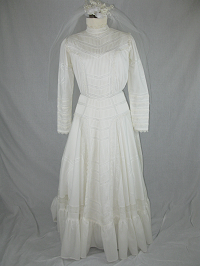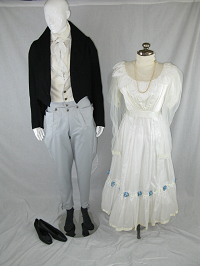
- Details
- Category: Weddings
- Hits: 2261
The buzz around a house where there is a wedding is not new; an observer in the 16th century likened the activity to a bee hive, suggesting perhaps, how the word "honey" came to be associated with sweethearts and weddings. The day following a wedding was often an open house, with guests dropping by throughout the day. Gentlemen visited the bridegroom's house to give joy to his father; others paid compliments to the bride's mother.
The blissful first few weeks of the marriage were known as the "honey month," the beginning of the tradition now known as the "honeymoon."
- Details
- Category: Weddings
- Hits: 2661
Like all the style shows, the wedding shows were the result of much research. Here are a few wedding traditions that were collected along the way.
The engagement
- After the betrothal, if a woman were to call off the wedding her fiancé had the right to claim half of her worldly goods.
- Early engagement rings were simple gold bands, with no stone. A message or poem was often engraved in the ring.
- Engagement rings today typically feature a diamond, but in the past, emerald, amethyst, ruby, epidote, sapphire, and turquoise were not uncommon.
- The authoritative evolution of the engagement ring
- A history of engagement rings
- In most states, parental consent was needed if a girl younger than 12 years old wanted to marry.
Choosing a day
- Bad weather on way to wedding meant unhappiness; wind and rain meant a stormy marriage.
- Which month?
- January was associated with the Greek goddess Hera, protectress of wives and fertility.
- The most solemn periods of the Christian and Jewish faiths occur during February and March. Catholic refrained from marrying during Lent (“marry in Lent, live to repent”), and Jews did not marry between Passover and Shabouth.
- April - spring, rebirth - a rich harvest of offspring.
- May - marry in May, rue for aye.
- June - for Juno, Roman queen of heaven and goddess of femininity and marriage.
- July and August - they that wive between sickle and scythe shall never thrive.
- September - harvest moon - good luck.
- November - larders full and cold winter coming.
- December - Dec. 31 - ring out the old, ring in the new.
- Choose the marriage day - Monday for wealth; Tuesday for health; Wednesday best day of all; Thursday for losses; Friday for crosses (hang man's day); Saturday no luck at all.
The Gown
- It was bad luck for the bride to make her own gown.
- The last stitch of the gown should be on the wedding day.
- A great overview of wedding dress traditions from the BBC
The rings
- Rings, with no beginning and no end, are the perfect symbol of eternity.
- Rings are worn on the third finger of left hand; it was believed that a vein from this finger ran directly to the heart.
The bride
- The bride should carry something OLD, for a sense of continuity; something NEW, expressing optimism; something BORROWED so that happiness rubs off; and something BLUE representing purity, fidelity and love.
- Penny in her shoe ensured a life of fortune.
- A pocket in hem of bride's petticoat might contain bread, cloth, a sliver of wood, money – things that would protect against future want of food, clothing, shelter, money.
- If you are married in white, you have chosen right; green - ashamed to be seen; gray - will go far away; red - wish yourself dead; blue - love ever true; yellow - ashamed of your fellow; black - will wish yourself back; pink - of you he'll always think.
- Although white would not become a tradition for brides until the end of the 19th century, the beginning of the century did see bride's wearing white. Everyone wore the white and pastel cottons so popular during the first two decades of the century. Mourning traditions dictated black dresses in the trousseau, too.
- First wedding bouquets were herbs of strong aromas to ward off evil spirits. Rosemary for remembrance, dill provoked lust and eaten for its power.
- A bride should not look in a mirror after she is completely dressed.
Travel
- Tin cans on the back of the carriage were said to scare away evil spirits.
Page 1 of 2


